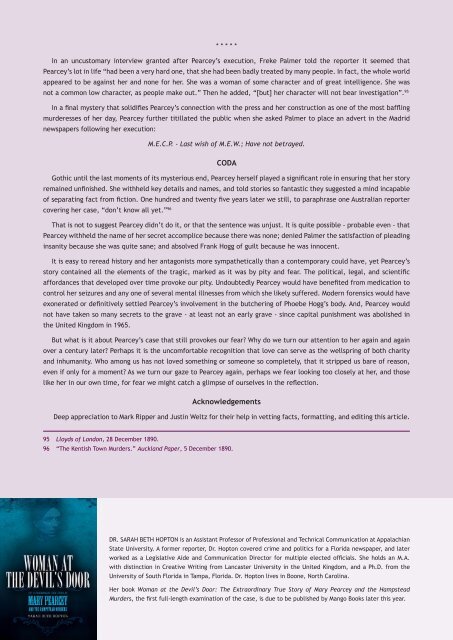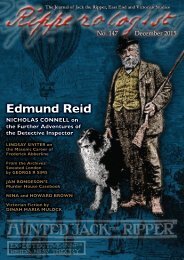GEORGE HUTCHINSON
orxwju5
orxwju5
You also want an ePaper? Increase the reach of your titles
YUMPU automatically turns print PDFs into web optimized ePapers that Google loves.
* * * * *<br />
In an uncustomary interview granted after Pearcey’s execution, Freke Palmer told the reporter it seemed that<br />
Pearcey’s lot in life “had been a very hard one, that she had been badly treated by many people. In fact, the whole world<br />
appeared to be against her and none for her. She was a woman of some character and of great intelligence. She was<br />
not a common low character, as people make out.” Then he added, “[but] her character will not bear investigation”. 95<br />
In a final mystery that solidifies Pearcey’s connection with the press and her construction as one of the most baffling<br />
murderesses of her day, Pearcey further titillated the public when she asked Palmer to place an advert in the Madrid<br />
newspapers following her execution:<br />
M.E.C.P. - Last wish of M.E.W.; Have not betrayed.<br />
CODA<br />
Gothic until the last moments of its mysterious end, Pearcey herself played a significant role in ensuring that her story<br />
remained unfinished. She withheld key details and names, and told stories so fantastic they suggested a mind incapable<br />
of separating fact from fiction. One hundred and twenty five years later we still, to paraphrase one Australian reporter<br />
covering her case, “don’t know all yet.” 96<br />
That is not to suggest Pearcey didn’t do it, or that the sentence was unjust. It is quite possible - probable even - that<br />
Pearcey withheld the name of her secret accomplice because there was none; denied Palmer the satisfaction of pleading<br />
insanity because she was quite sane; and absolved Frank Hogg of guilt because he was innocent.<br />
It is easy to reread history and her antagonists more sympathetically than a contemporary could have, yet Pearcey’s<br />
story contained all the elements of the tragic, marked as it was by pity and fear. The political, legal, and scientific<br />
affordances that developed over time provoke our pity. Undoubtedly Pearcey would have benefited from medication to<br />
control her seizures and any one of several mental illnesses from which she likely suffered. Modern forensics would have<br />
exonerated or definitively settled Pearcey’s involvement in the butchering of Phoebe Hogg’s body. And, Pearcey would<br />
not have taken so many secrets to the grave - at least not an early grave - since capital punishment was abolished in<br />
the United Kingdom in 1965.<br />
But what is it about Pearcey’s case that still provokes our fear? Why do we turn our attention to her again and again<br />
over a century later? Perhaps it is the uncomfortable recognition that love can serve as the wellspring of both charity<br />
and inhumanity. Who among us has not loved something or someone so completely, that it stripped us bare of reason,<br />
even if only for a moment? As we turn our gaze to Pearcey again, perhaps we fear looking too closely at her, and those<br />
like her in our own time, for fear we might catch a glimpse of ourselves in the reflection.<br />
Acknowledgements<br />
Deep appreciation to Mark Ripper and Justin Weltz for their help in vetting facts, formatting, and editing this article.<br />
95 Lloyds of London, 28 December 1890.<br />
96 “The Kentish Town Murders.” Auckland Paper, 5 December 1890.<br />
<br />
DR. SARAH BETH HOPTON is an Assistant Professor of Professional and Technical Communication at Appalachian<br />
State University. A former reporter, Dr. Hopton covered crime and politics for a Florida newspaper, and later<br />
worked as a Legislative Aide and Communication Director for multiple elected officials. She holds an M.A.<br />
with distinction in Creative Writing from Lancaster University in the United Kingdom, and a Ph.D. from the<br />
University of South Florida in Tampa, Florida. Dr. Hopton lives in Boone, North Carolina.<br />
Her book Woman at the Devil’s Door: The Extraordinary True Story of Mary Pearcey and the Hampstead<br />
Murders, the first full-length examination of the case, is due to be published by Mango Books later this year.<br />
Ripperologist 146 October 2015 29




